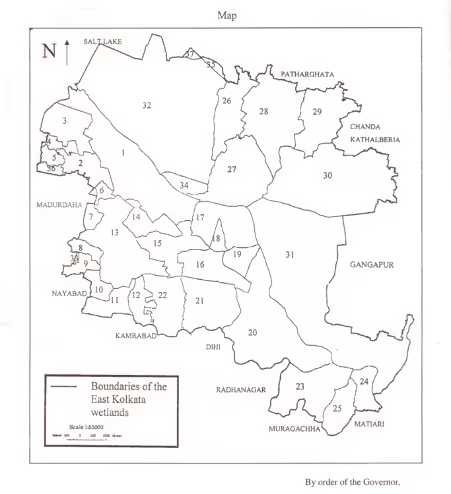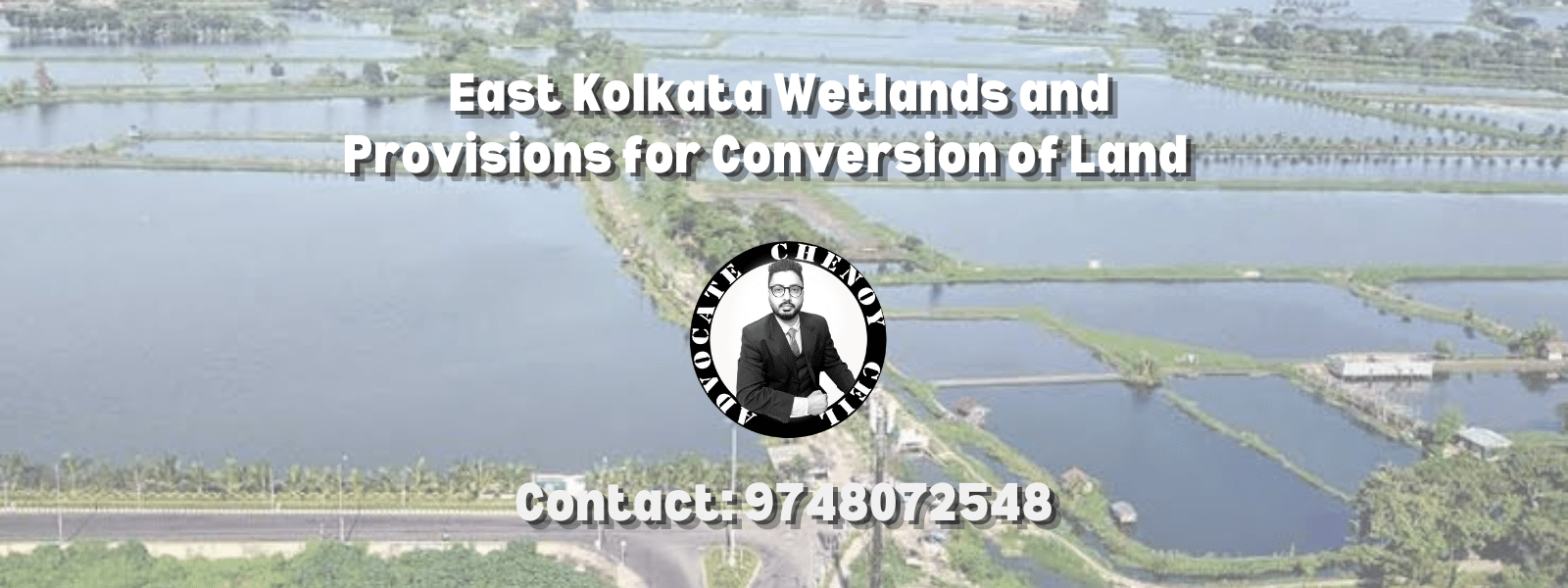East Kolkata Wetlands and provision for conversion of land is an important aspect to understand how wetlands are governed within West Bengal.
Table of Contents
East Kolkata Wetlands
Wetlands in West Bengal, particularly the East Kolkata Wetlands, represent critical ecosystems that demand stringent conservation measures. Governed by The East Kolkata Wetlands (Conservation and Management) Act, 2006, these regulations ensure the preservation of wetland areas and restrict any unauthorized repurposing of land within them. The Act mandates stringent procedures for any alterations in land usage, emphasizing the preservation of essential characteristics and environmental sustainability. Provisions under this Act, along with associated rules and case law, underscore the paramount importance of safeguarding these ecosystems against developmental pressures. For better understanding about the East Kolkata Wetlands and the provisions for conversion of land usage, it is advised to consult an experienced property lawyer in Kolkata and West Bengal.
The East Kolkata Wetlands (Conservation and Management) Act, 2006
According to Section 9 of The East Kolkata Wetlands (Conservation and Management) Act, 2006 despite any provisions in current legislation, individuals owning land in the East Kolkata wetlands must uphold and protect it to ensure its area remains unchanged, its essential characteristics remain intact, and it isn’t repurposed for any use other than its original settlement or prior purpose, unless authorized by the Authority as per Section 10. This is one of the provisions for maintenance, management and protection of Wetlands in West Bengal.
Any individual holding land within the East Kolkata Wetlands may submit an application to the Authority, following prescribed procedures, seeking a change in the land’s character or its mode of use. Upon receiving the application, the Authority will assess its merits and, if deemed necessary, conduct an inspection of the proposed site. Following examination and any inspection conducted under Section 10, subsection 2, the Authority will forward the case to the Collector of the relevant District for appropriate action under section 4C of the West Bengal Land Reforms Act, 1955. Section 4C of the West Bengal Land Reforms Act, 1955 provides a similar provision for alteration or conversion of the character of the land within West Bengal. Upon receiving the Collector’s order, the Authority may issue an order granting approval for the change in character or mode of use, subject to prescribed form, restrictions, and conditions. It is stipulated that if such approval could lead to the filling of any water body, the Authority must require the applicant to create, within the East Kolkata Wetlands, a water body of equal or greater area prior to granting approval. Importantly, the Authority is not empowered to grant approval for changes unless they contribute to the enhancement or preservation of the local environment and its surroundings. To understand this Act more clearly, please consult an experienced property lawyer in Kolkata and West Bengal.
According to the Schedule 1 of the EKWCM Act, 2006 the wetlands of East Kolkata are as follows:
| District | Police Station | Mouza | J.L. No. |
| (1) | (2) | (3) | (4) |
| 24-Parganas (South) | Tiljola | Dhapa Chowbaga Bonchtala Dhalenda Paschim Chowbaga Nonadanga | 2 3 4 8 9 10 |
| Sonarpur | Chak Kolar Khal Karimpur Jagatipota Mukundapur Atghara Ranabhutia Kantipota Bhagabanpur Kharki Deara Kheadaha Khodahati Goalpota Kumapukuria Tardaha Tihuria Nayabad Samukpota Pratapnagar Garal | 1 2 3 4 5 6 7 8 9 10 11 12 13 14 15 16 17 91 92 93 | |
| Kolkata Leather Complex | Dakshin Dhapa Manpur Dhapa Manpur (presently Kochpukur) Hatgachha Hadia Dharmatala Pachuria Kulberia Beonta Tardaha Kapashati | 1 2 4 5 6 7 27 38 | |
| Purba Jadabpur | Kalikapur | 20 | |
| 24-Parganas (North) | South Bidhan Nagar | Dhapa Manpur | 1 |
| Rajarhat | Thakdari | 19 |

East Kolkata Wetlands (Conservation and Management) Rules, 2006:
Individuals who own land within the East Kolkata Wetlands have the right to apply for a change in the land’s character or mode of use. This application must be submitted to the Authority using Form 1 in triplicate. Alongside the application, fees determined by the Authority must be provided.
In Form 1, the following details are required:
A. Name of the applicant
B. Permanent address/ Phone Number of the applicant
C. Details of the land
D. Proposed change of character of the land
E. Purpose of the proposed change
F. Details of the activity proposed
Upon receiving the application, the Authority will acknowledge its receipt. Subsequently, the Authority will assess the application’s merit. If deemed necessary, the Authority may arrange for an expert committee to inspect the proposed site.
In instances where the Authority finds no merit in the application, the applicant will be given an opportunity to present their case. Following this, if the Authority still believes the application lacks merit, it has the right to reject it. The Authority must inform the applicant of this decision within sixty days of receiving the application, providing reasons for the rejection.
After thorough examination and site inspection, the Authority will forward the application along with its observations to the Collector of the relevant district within sixty days. This is done to facilitate the necessary steps for issuing an order under section 4C of the West Bengal Land Reforms Act, 1955 (West Ben. Act X of 1956). Only an experienced property lawyer in Kolkata and West Bengal can guide you in this regard, especially if you are seeking conversion of wetlands, ponds, pukur or doba and marshy lands.
Case Law Study:
In the case of Splendour Commercial Pvt. Ltd. & Anr. vs. East Kolkata Wetlands Management Authority & Ors., the petitioners sought to convert agricultural land into non-agricultural for constructing a school building. Despite submitting the application well within the mandated time frame, the authority failed to process it. The respondents, citing environmental regulations, argued against the conversion, highlighting Rule 4(VI) of the Wetlands (Conservation & Management) Rules, 2010, which prohibits permanent construction within wetlands. Given that the petitioners’ land fell within the East Kolkata Wetlands area, the honourable High Court of Calcutta upheld the environmental regulations, refusing to direct the authority to consider the application further. The judgment of the Calcutta High Court emphasizes the paramount importance of environmental conservation over developmental interests in ecologically sensitive areas like wetlands, ultimately leading to the rejection of the writ petition. To fight this kind of hazardous and complicated cases, please contact an experienced property lawyer in Kolkata and West Bengal.
Conversion Provisions for East Kolkata Wetlands
The legal framework surrounding wetland conservation in West Bengal, exemplified by The East Kolkata Wetlands (Conservation and Management) Act, 2006, stands as a testament to the state’s commitment to environmental preservation. Through meticulous procedures outlined in the Act and subsequent rules, coupled with judicial precedents such as the Splendour Commercial Pvt. Ltd. & Anr. vs. East Kolkata Wetlands Management Authority & Ors. case, the significance of protecting wetlands from unchecked developmental activities is unequivocally affirmed. These measures not only ensure the preservation of biodiversity but also acknowledge the vital role wetlands play in mitigating climate change and supporting local ecosystems. A property lawyer in Kolkata and West Bengal can guide you more about such conversion provisions for East Kolkata wetlands.
For more information on East Kolkata Wetlands and provision for conversion of land, contact here.
